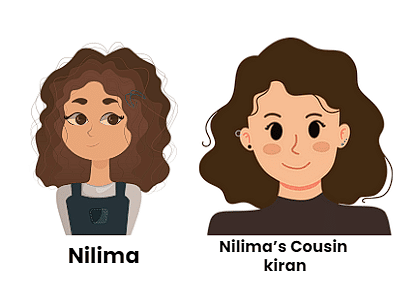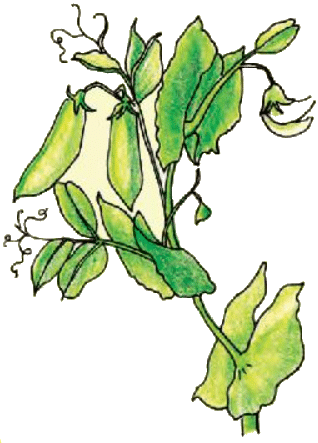Like Father, Like Daughter Class 5 Notes EVS Chapter 21
| Table of contents |

|
| Introduction |

|
| Aaa Chhee!! |

|
| Who is Whose Aunt? |

|
| How We Are All Related! |

|
| Is this a mirror |

|
| This from the family |

|
| But not this from Parent |

|
Introduction
The chapter “Like Father, Like Daughter” is about how children are similar to their parents, and why they behave like their parents or relatives. The author tried to make the kids understand how these characters passed from parents to their kids.
Aaa Chhee!!
Ashima was sitting near the window and reading. It was windy and dusty outside and suddenly Ashima sneezed loudly – aaa chhee. Ashima’s parents were sorting vegetables in the kitchen. After hearing the Ashima’s sneeze her mother said to his father that she sneezes like him. She said if he would not have been with her, she might have thought it was him sneezing.

Who is Whose Aunt?
Nilima visited her maternal grandmother during the school holidays. Spotting someone approaching, she hurried to inform her mother, saying, "Mom, one of your sisters has arrived to see you." Her mother emerged to greet the visitor and corrected Nilima, saying, "No, she's not your aunt. She's your sister Kiran. Remember your eldest grandmother? Kiran is the daughter of her older son. She's your cousin sister.
Actually, you're Samir's aunt – he's Kiran's adorable son!"
 Who is whose aunt
Who is whose aunt
How We Are All Related!
While nilima started playing with Samir. Her mother called Kiran and said, have you noticed nilima’s hair thick, curly and black just same as yours unlike mine – straight, limp and brown!”

Nilima’s Nani laughed and said, “Yes, isn’t it strange? Nilima’s Nani’s sisters had thick curly hair and now our second generation has similar hair.” Nilima was listening to all this. She thought, “We are called ‘distant relatives, but how closely related we are in many ways!”
Is this a mirror
Is Saroja standing in front of a mirror? No, this is her twin! Did you get confused? Their mother’s brother (mama) also gets confused when he sees them together. At times Saroja gets scolded for the mischief done by Suvasini. Sometimes Suvasini tricks her mama and says, “Suvasini has gone out.” But now mama has learnt a trick. She says — Sing a song in Marathi! Why this funny trick?

- The sisters were just two weeks old when Saroja’s father’s brother’s wife (Chachi) adopted her and took her to Pune. Everyone in chachi’s house is very fond of music. Saroja knows many songs in both languages – Tamil and Marathi. At home, everyone speaks Kashmiri and at school, most children speak Urdu.
- Suvasini stays with her father in Chennai. Her father is a karate coach. Since she was there, Suvasini started doing karate with the other children. On holidays, both father and daughter start practising in the morning.
- Saroja and Suvasini look alike but are also quite different. Do you now know why mama has his way of finding out who is who?
- Saroja and Suvasini look a lot like each other yet are different. For example, Saroja knows two languages. If Suvasini’s family also talked in two languages she could also learn both. We learn many things like language, music, love for reading, or knitting when we get a chance and an environment to do so.
This from the family
If you could do any of these you should ask if your family members also do so. There would a member in your family who could so, it means you have got this trait from your family members.
- Without touching your teeth fold your tongue towards the back of your mouth.
- Roll your tongue by lifting it from the sides.
- Open all the toes of your feet. Now without moving the others, move the little toe.
- Touch the thumb to your wrist.
- Make a ‘V’ by separating two fingers of your hand to each side.
- Move your ears, without holding them.
But not this from Parent
Satti was only a few months old when one of her legs was affected by polio. But she never let this come in the way of her work and her life. Walking long distances and climbing many stairs have been a part of her work. Now Satti is married. Some people tell her not to have any children. She is also worried that her children may also get polio. She spoke to a doctor about this.
Experiments with Peas – Rough or Smooth?
Gregor Mendel was born in a poor farmer’s family in Austria in 1822. He was very fond of studies but the very thought of examinations made him nervous (Oh! you too feel the same!). He did not have money to study at the University so he thought of becoming a ‘monk’ in a monastery. He thought from there he would be sent to study further. Which he was. But to become a science teacher he had to take an exam. Oh no! he got so nervous that he kept running away from the exam, and kept failing!- But he did not stop doing experiments. For seven years he did experiments on 28,000 plants in the garden of the monastery. He worked hard, collected many observations, and made a discovery! Something which scientists at that time could not even understand! They understood it many years after his death when other scientists did such experiments and read what Mendel had already written.
- What did Mendel find in those plants? He found that the pea plant has some traits which come in pairs. Like the seed is either rough or smooth. It is either yellow or green, and the height of the plant is either tall or short. Nothing in between.

- The next generation (the children) of a plant which has either rough or smooth seeds will also have seeds which are rough or smooth. There is no seed which is mixed – a bit smooth and a bit rough.
- He found the same colour. Seeds which are either green or yellow give rise to new seeds which are either green or yellow. The next generation does not have seeds with a mixed new colour made from both green and yellow. Mendel showed that in the next generation of pea plants there will be more plants having yellow seeds. He also showed that the next generation will have more plants with smooth seeds. What a discovery!
Conclusion
- The traits of children resemble their parents.
- Sometimes some traits like—the colour of eyes, dimples in cheeks, height, broad or sharp nose, voice etc. resemble distant relatives.
- Scientist Gregor Mendel was born in Austria in 1822.
- Mendel did experiments on pea plants and found that like-the seed is either rough or smooth.
- The next generation of a plant with either rough or smooth seeds will also have rough or smooth seeds.
- We get some traits from our parents at birth. We acquire some habits or traits from our surroundings.
- Sometimes we recognise a person from his voice or loud laughter.
|
37 videos|244 docs|41 tests
|
FAQs on Like Father, Like Daughter Class 5 Notes EVS Chapter 21
| 1. Who is considered an aunt in a family? |  |
| 2. How are we all related in a family tree? |  |
| 3. Is a mirror image considered part of the family tree? |  |
| 4. Can someone be considered part of the family without being a direct parent or sibling? |  |
| 5. Are all family members related in some way? |  |















